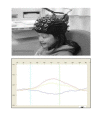Functional near-infrared spectroscopy studies in children
- PMID: 22433235
- PMCID: PMC3337812
- DOI: 10.1186/1751-0759-6-7
Functional near-infrared spectroscopy studies in children
Abstract
Psychosomatic and developmental behavioral medicine in pediatrics has been the subject of significant recent attention, with infants, school-age children, and adolescents frequently presenting with psychosomatic, behavioral, and psychiatric symptoms. These may be a consequence of insecurity of attachment, reduced self-confidence, and peer -relationship conflicts during their developmental stages. Developmental cognitive neuroscience has revealed significant associations between specific brain lesions and particular cognitive dysfunctions. Thus, identifying the biological deficits underlying such cognitive dysfunction may provide new insights into therapeutic prospects for the management of those symptoms in children. Recent advances in noninvasive neuroimaging techniques, and especially functional near-infrared spectroscopy (NIRS), have contributed significant findings to the field of developmental cognitive neuroscience in pediatrics. We present here a comprehensive review of functional NIRS studies of children who have developed normally and of children with psychosomatic and behavioral disorders.
Figures



References
-
- Oki J, Eto T, Yamagata Z. Survey of neurosis and psychosomatic diseases among children in hospitals and schools in Japan. Jpn J Pediatr Soc. 2001;105:1317–1323. in Japanese.
-
- The Japanese Society of Psychosomatic Pediatrics. The Clinical Guidelines on Psychosomatic Diseases in Childhood by The Japanese Society of Psychosomatic Pediatrics (in Japanese) Tokyo: Nankoudo Press; 2009.
LinkOut - more resources
Full Text Sources

